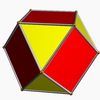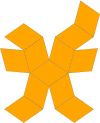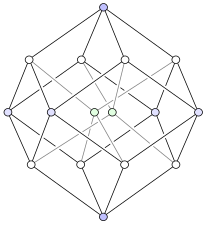Rhombic dodecahedron: Difference between revisions
→External links: added subcat |
→External Links: added refs |
||
| Line 42: | Line 42: | ||
== External links == |
== External links == |
||
* {{Mathworld2 | urlname= RhombicDodecahedron | title=Rhombic dodecahedron | urlname2 = CatalanSolid| title2 = Catalan solid}} |
* {{Mathworld2 | urlname= RhombicDodecahedron | title=Rhombic dodecahedron | urlname2 = CatalanSolid| title2 = Catalan solid}} |
||
| ⚫ | |||
*[http://www.georgehart.com/virtual-polyhedra/vp.html Virtual Reality Polyhedra] – The Encyclopedia of Polyhedra |
*[http://www.georgehart.com/virtual-polyhedra/vp.html Virtual Reality Polyhedra] – The Encyclopedia of Polyhedra |
||
===Computer models=== |
|||
| ⚫ | |||
* [http://demonstrations.wolfram.com/RelatingARhombicTriacontahedronAndARhombicDodecahedron/ Relating a Rhombic Triacontahedron and a Rhombic Dodecahedron], [http://demonstrations.wolfram.com/RhombicDodecahedron5Compound/ Rhombic Dodecahedron 5-Compound] and [http://demonstrations.wolfram.com/RhombicDodecahedron5Compound/ Rhombic Dodecahedron 5-Compound] by Sándor Kabai, [[The Wolfram Demonstrations Project]]. |
|||
===Paper projects=== |
===Paper projects=== |
||
Revision as of 18:08, 29 April 2008
| Rhombic dodecahedron | |
|---|---|
 (Click here for rotating model) | |
| Type | Catalan solid |
| Coxeter diagram | |
| Conway notation | jC |
| Face type | V3.4.3.4 rhombus |
| Faces | 12 |
| Edges | 24 |
| Vertices | 14 |
| Vertices by type | 8{3}+6{4} |
| Symmetry group | Oh, B3, [4,3], (*432) |
| Rotation group | O, [4,3]+, (432) |
| Dihedral angle | 120° |
| Properties | convex, face-transitive isohedral, isotoxal, parallelohedron |
 Cuboctahedron (dual polyhedron) |
 Net |
The rhombic dodecahedron is a convex polyhedron with 12 rhombic faces. It is an Archimedean dual solid, or a Catalan solid. Its dual is the cuboctahedron.
Properties
It is the polyhedral dual of the cuboctahedron, and a zonohedron. The long diagonal of each face is exactly √2 times the length of the short diagonal, so that the acute angles on each face measure cos−1(1/3), or approximately 70.53°.
Being the dual of an Archimedean polyhedron, the rhombic dodecahedron is face-transitive, meaning the symmetry group of the solid acts transitively on the set of faces. In elementary terms, this means that for any two faces A and B there is a rotation or reflection of the solid that leaves it occupying the same region of space while moving face A to face B.
The rhombic dodecahedron is one of the nine edge-transitive convex polyhedra, the others being the five Platonic solids, the cuboctahedron, the icosidodecahedron and the rhombic triacontahedron.

The rhombic dodecahedron can be used to tessellate 3-dimensional space. It can be stacked to fill a space much like hexagons fill a plane.
This tessellation can be seen as the Voronoi tessellation of the face-centred cubic lattice. Some minerals such as garnet form a rhombic dodecahedral crystal habit. Honeybees use the geometry of rhombic dodecahedra to form honeycomb from a tessellation of cells each of which is a hexagonal prism capped with half a rhombic dodecahedron.

The rhombic dodecahedron forms the hull of the vertex-first projection of a tesseract to 3 dimensions. There are exactly two ways of decomposing a rhombic dodecahedron into 4 congruent parallelepipeds, giving 8 possible parallelepipeds. The 8 cells of the tesseract under this projection map precisely to these 8 parallelepipeds.
Area and volume
The area A and the volume V of the rhombic dodecahedron of edge length a are:
Cartesian coordinates
The eight vertices where three faces meet at their obtuse angles have Cartesian coordinates
- (±1, ±1, ±1)
The six vertices where four faces meet at their acute angles are given by the permutations of
- (0, 0, ±2)
See also
- Dodecahedron
- Rhombic triacontahedron
- Truncated rhombic dodecahedron
- 24-cell - 4D analog of rhombic dodecahedron
- Rhombic dodecahedral honeycomb
References
- Williams, Robert (1979). The Geometrical Foundation of Natural Structure: A Source Book of Design. Dover Publications, Inc. ISBN 0-486-23729-X. (Section 3-9)
External links
- Weisstein, Eric W., "Rhombic dodecahedron" ("Catalan solid") at MathWorld.
- Virtual Reality Polyhedra – The Encyclopedia of Polyhedra
Computer models
- Rhombic Dodecahedron -- interactive 3-d model
- Relating a Rhombic Triacontahedron and a Rhombic Dodecahedron, Rhombic Dodecahedron 5-Compound and Rhombic Dodecahedron 5-Compound by Sándor Kabai, The Wolfram Demonstrations Project.
Paper projects
- Rhombic Dodecahedron Calendar – make a rhombic dodecahedron calendar without glue
- Another Rhombic Dodecahedron Calendar – made by plaiting paper strips
Practical applications
- Archimede Institute Examples of actual housing construction projects using this geometry



